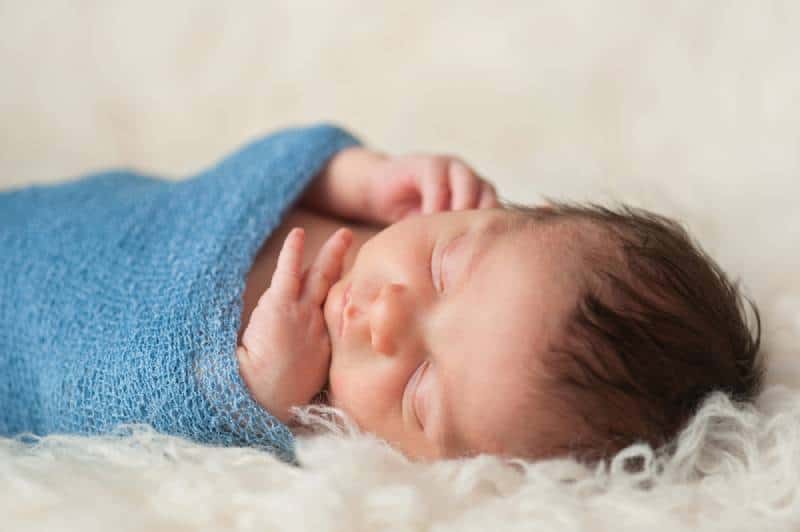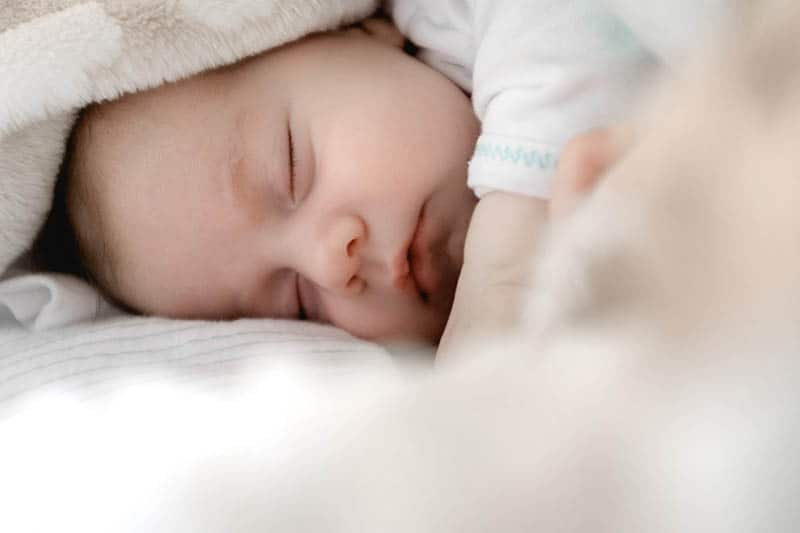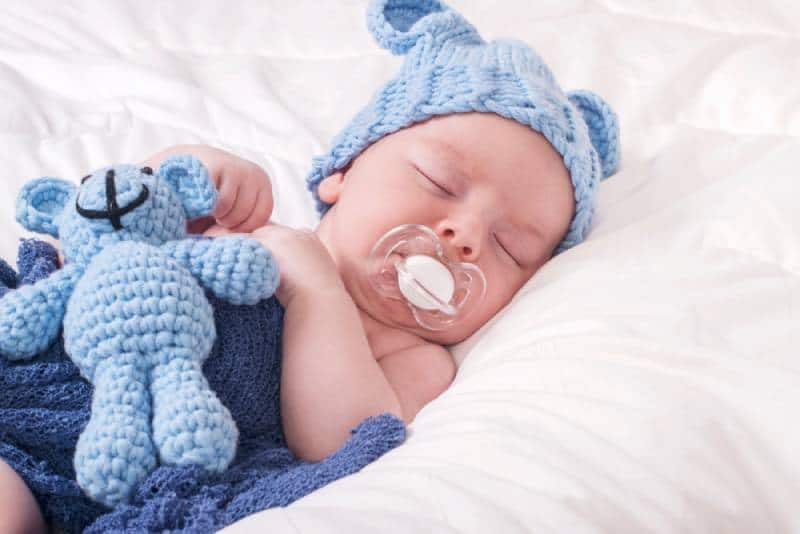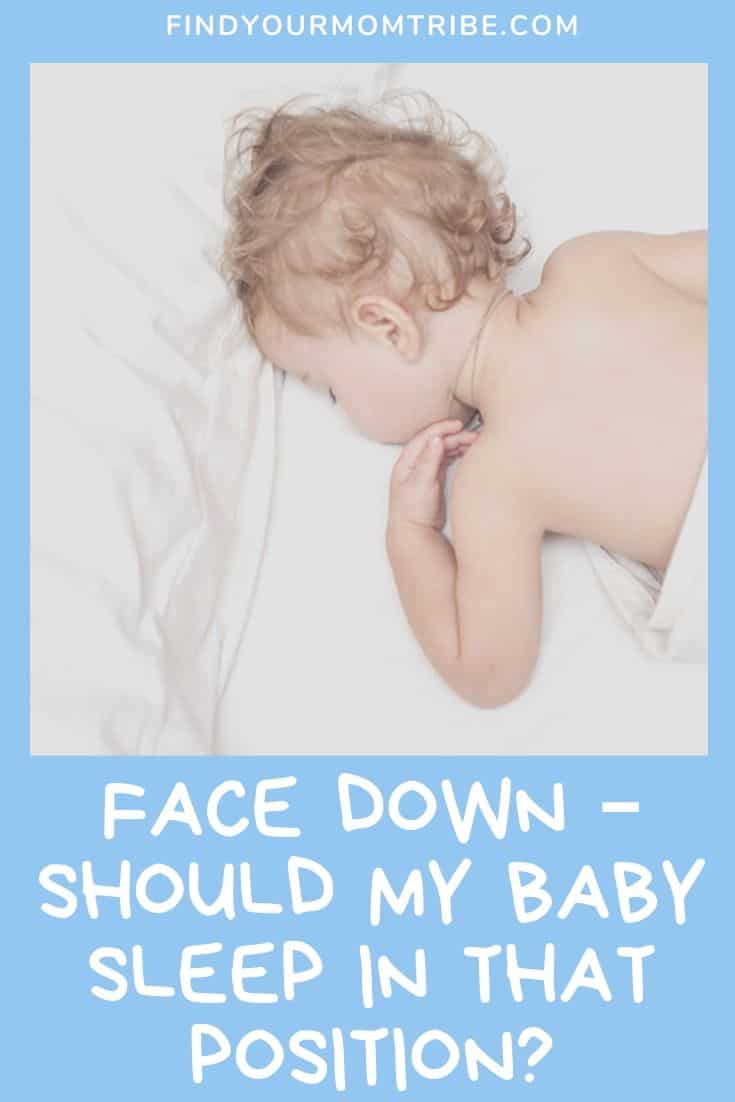The answer to that is an emphatic NO! Never!
The reason I am starting this article with the answer straight off, is because of the health risks to your baby if you even place them on their tummies or sides sometimes.
Placing your baby to sleep on its back (supine position) is the safest way for an infant to sleep.
This should be done for every sleep or nap.
You should not change this position in the first six months of your baby’s life at all. They need to sleep on their backs at every time, whether night or day.
The word SIDS (Sudden Infant Death Syndrome) strikes fear deep into the heart of every parent, and I am certain that you would do everything possible to ensure that your baby is not at risk.
There is no certainty about why sleeping on the back is best for baby, but some researchers think that if a baby sleeps on its tummy, it gets less oxygen and inhales carbon dioxide, especially if its nose gets stuck in the bedding.
Babies should get into the routine of sleeping on their backs from the word go, and it is important to remember that you increase the risk of SIDS if you let baby sleep on its tummy even every now and again.
That is not to say that baby should never have any tummy time.
When baby is first born, it is a wonderful position for baby to lie in for a cuddle.
Also, as time goes on, it is vital for baby to strengthen its neck and shoulder muscles while lying on its tummy.
Your little one will learn to roll over and crawl from this position and all these movements will lead to safer sleeping positions after the one year old mark.
Once your baby has mastered all those actions, you will not need to worry about whether it is sleeping on its back or not.
If you have any concerns about putting baby down on its back, or baby won’t settle unless it can sleep face down, speak to your pediatrician.
Premature babies and babies with breathing problems (baby sleeping with mouth open could lead to this, so be careful) will need specialist advice.
Is this sleeping position based on research?

In the past, most parents put their babies to sleep on their tummies – face down – because that is what the medical advice was in those days.
Then in the 1990s, it was noted that thousands of babies were dying unexpectedly.
This became known as “cot death,” but that term is no longer used because it implies that a baby can only suddenly die if it is left asleep in a cot.
This is entirely untrue.
If the babies were found to have no infection or congenital disorder, it was called Sudden Infant Death Syndrome or SIDS.
A researcher found some interesting data regarding low SIDS instances amongst Chinese babies, who were always placed on their backs, and the possibility of this being a solution to the problem was brought into the Western world.
The Safe to Sleep campaign (previously known as The Back to Sleep Campaign) was started in 1994 and the rate of SIDS has since dropped by more than 50%.
What is the cause of SIDS?
Even after years of research, there is no clarity on what the sad, unexpected, and sudden cause of death of a baby might be.
It is an unfortunate combination of factors that result in a baby dying without warning and without any evidence of symptoms that may have been missed by parents or doctors.
There continues to be a number of research projects taking place to this day to try and find the causes of SIDS and also to be able to identify which babies may have a greater risk of dying unexpectedly.
It is important to keep your fear of SIDS under control and not worry excessively about it.
The fact is, SIDS is rare and you should not let any additional worry spoil your first months with your baby.
I am sure you have more than enough to keep you awake at night!
Safe sleep for babies

The American Academy of Pediatrics (APP) recommend several things parents can do to protect babies and help them to sleep safely.
It is important to note that SIDS cannot be prevented, but there are things that can be implemented that are known to reduce the risks.
– Lay baby down to sleep on their back.
– Babies should sleep in an unencumbered, flat sleep space (e.g. a cot or Moses basket) for the first six months.
- LIGHTS AND SOUNDS: Features a calming nightlight and soothing music. Baby bassinet requires 4 AA batteries (not included)
- PERFECT FOR NAPS OR BEDTIME: Adjustable, removable canopy helps block light to create a serene sleep environment
- EASY TO USE: Large storage basket provides ample storage for all things baby | Locking wheels for easy room-to-room mobility | Includes mattress pad and fitted sheet
- SIZE: 21 L x 35.5 D x 45.5 H Inches
Prices pulled from the Amazon Product Advertising API on:
Product prices and availability are accurate as of the date/time indicated and are subject to change. Any price and availability information displayed on [relevant Amazon Site(s), as applicable] at the time of purchase will apply to the purchase of this product.
Make sure that you fit a firm mattress, preferably new and waterproof, covered in a simple sheet, as that is all that your baby needs.
There should not be any gaps on the sides where baby can get trapped. Baby does not need any pillows, quilts, duvets, wedges, or bumpers.
– Do not surround baby with soft toys that could block airways and cause suffocation, no matter how cute they look.
– It is not necessary to use any restraints or products, such as pods, nests, or sleep positioners to keep a baby asleep on their backs.
– It is best for baby to sleep in a one-piece sleeping garment.
- Six-piece set featuring two long-sleeve bodysuits, two short-sleeve bodysuits, and two pairs of pants
- Lapped neckline, expandable shoulders, and nickel-free snaps
- One pant with covered elastic waistband and back applique
- One pant with covered elastic waistband and ribbed cuffs
Prices pulled from the Amazon Product Advertising API on:
Product prices and availability are accurate as of the date/time indicated and are subject to change. Any price and availability information displayed on [relevant Amazon Site(s), as applicable] at the time of purchase will apply to the purchase of this product.
– A sleep sack is also safe if it is a bit chilly. Do not use blankets and remember to keep baby out of drafts.
In fact, new babies should not be exposed to any temperature extremes or direct sunlight.
- Sleeveless easy on zip front sleep bags
- Worry free safety tab keeps zipper away from babys chin and neck
Prices pulled from the Amazon Product Advertising API on:
Product prices and availability are accurate as of the date/time indicated and are subject to change. Any price and availability information displayed on [relevant Amazon Site(s), as applicable] at the time of purchase will apply to the purchase of this product.
– Make sure that the sleep environment is smoke-free at all times.
At no time should babies be left in the care of adults who are smoking, abusing alcohol, or using illegal drugs.
Even your best friend should not be permitted to smoke near your precious baby.
– Keep baby in the same room as you for at least the first six months, but co-sleeping is not advised as there is the risk of the sleeping baby being inadvertently smothered.
Take care, especially in the first few weeks when baby may fall asleep in your arms, and when you are exhausted.
A cot or crib, beside your bed, is the safest place for baby to sleep.
– Baby’s head should not be covered with bedding or hats in bed in case it gets too hot.
You should place them in the “feet to foot” position, meaning that their feet are at the end of the cot or crib and this prevents them from moving down under the covers and suffocating.
– Dummies or pacifiers may reduce the risk of SIDS, but only introduce them when breastfeeding your baby is well established.
– It is not advisable to share your bed with baby. This is even more important if parents are smokers, as it can increase the risk of SIDS by 10%.
– You should never sleep with baby in a chair or on a sofa. They could fall from your arms when you are asleep or roll into a gap and get trapped.
– If possible, breastfeed your baby for at least two months, as that will give them the best start in life and halve the risk of SIDS.
– Ensure that your baby’s immunisation programme is up-to-date will help to prevent infections and illness.
Regular check-ups at the baby clinic will also help to put your mind at rest and give parents the chance to ask questions and allay fears about SIDS.
You should also see a doctor if you suspect that your baby is ill because it is often difficult to assess whether they are suffering from something serious or not.
– The APP have also issued advice against using a baby monitor, as they often provide inaccurate readings and could give parents a false sense of security about the risk factor of SIDS.
There is no evidence that a breathing monitor can prevent sudden death in babies.
– Babies are at risk of having breathing problems if they are left asleep in a car seat.
When you get home, place your sleeping baby into its cot or Moses basket as soon as possible, even at the prospect of waking them up. It is not worth the risk, however inconvenient.
– If your baby’s sleeping routine or sleeping environment changes (e.g. baby is being babysat at a relative’s house or you are having a party), be aware that they still need the same safe sleeping arrangements.
Changed sleep routines have sometimes been part of the scenario described by parents of babies that have died suddenly.
Does swaddling help to keep baby on its back?

This tradition probably came about as mothers were trying to recreate the cosy comfort of the womb after the baby had entered the world.
It usually helps to comfort baby and encourages them to fall asleep.
In the children’s hospital, new moms are often taught how to swaddle a baby. There is certainly some skill involved in getting it just right.
However, medical practitioners are divided in their opinions on whether swaddling is safe for babies, especially when they are being placed on their backs.
There are guidelines for swaddling safely, and these should be observed.
One of the risks of swaddling is that baby could overheat, especially when breastfeeding. They could also struggle to latch on when breastfeeding if their arms are restricted.
It seems that swaddled babies sleep more deeply, which is not necessarily a good thing as it could be a SIDS risk and they also feed less frequently, which could affect health growth and development.
When is it safe to change baby’s sleep position?
When baby has developed strong enough muscles to turn and change sleeping position with ease, which is usually after six months of age, then it becomes safe for baby to sleep in its own chosen position.
The greatest risk of SIDS is from birth to six months of age (with sudden death happening most often between 2 and 4 months of age), so it is advisable to keep placing baby on its back to sleep for the first year of life.
Yes, do check on your baby and change its sleeping position if it has turned onto its tummy.
Hopefully your little one will settle into a routine and then it will no longer be necessary to do this.

Back sleeping – Are there side effects?
Choking
You may be concerned about your baby choking when it is sleeping on its back.
There is no evidence that a healthy baby sleeping on its back increases the risks of choking when compared with other sleeping positions.
There are a number of other concerns that parents have had about placing baby on its back to sleep.
Misshapen head
One such concern is baby developing a flat head.
The bones in a baby’s head are purposefully designed to be flexible, especially during the birthing process – thank goodness!
If sleeping on its back seems to create a flat spot, you do not need to be concerned about it because this will even out as the bones firm up during normal development.

In conclusion
I cannot emphasise enough how important it is for your baby to sleep on its back from the first moment that it is placed in a cot – right there in the maternity wing!
You need to have the confidence, even as a young mom, to stand up to those from a different generation who may try to persuade you to do it their way.
You might not remember the long list of reasons why they should sleep on their backs, or exactly what is right or wrong when it comes to baby’s bedtime, but if you stick to that one basic rule, you know you are on the right track in putting your baby down to sleep in the safest possible position.
When you have time, you can go back through the checklist and make sure that everything is in place to ensure that your baby has the safest sleeping environment that you can possibly provide.
Also, don’t forget to read up on the different positions babies can try to sleep in, such as sleeping with their butt in the air.
READ NEXT: Baby Sleep Consultant: 4 Tips To Try Before Seeking Help
Like this article? Please share or pin it for later. You can also stay in the loop and follow me on Facebook, Instagram and Pinterest.

We love honesty! Find Your Mom Tribe is an Amazon Associate and we earn from qualifying purchases through affiliate links at no extra cost to you. Please see our full Amazon Affiliate disclosure for more information.

